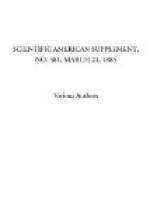Regenerator burners for lighting are coming into use; and, where large lights are required for long periods, no doubt they are economical. Burners of the Bower or Wenham class would be worth adopting for main street or open space lighting in important positions; but when we consider that, with the fifty-four hours’ system in workshops, artificial light is only wanted, on an average, for four hundred hours per annum, we may take it as certain that, at the present prices of regenerator burners, they are a bad investment for use in ordinary work. We must not forget that the distance of the burner from the work is a vital point of the cost question; and, for all except large spaces, requiring general illumination, a common cheap burner on a swivel joint has yet to meet with a competitor. Do not think I am old-fashioned or prejudiced in this matter. It is purely a question of figures; and my condemnation of regenerator burners applies only to the general requirements in ordinary engineering and other work shops where each man wants a light on one spot only.
Some people think that clear glass does not stop any light. This is a great mistake, as you will find it quite easy to throw a distinct shadow of a sheet of perfect glass on a white paper, as I will show you. Opal and ground glass throw a very strong shadow, and practically waste half the light. It is better to have a white enameled or whitewashed sheet-iron reflecting hood, which will protect the sides from wind, if such an arrangement suits other requirements.
I have endeavored in the engraving below to reproduce the shadows thrown by different samples of glass. This gives a fair idea of the actual loss of light involved by glass shades.
When lights are suspended, it is a common and costly fashion to put them high up. When we consider that light decreases as the square of the distance, it will be readily understood that to light, for instance, the floor of a moulding shop, a burner 6 feet from the floor will do as much work as four burners, the same size, placed 12 feet from the floor. It is therefore a most important matter that all lights should be as low as possible, consistent with the necessities of the shop, as not only is the expense enormously increased by lofty lights, but the air becomes more vitiated and unpleasant, interfering with the men’s




